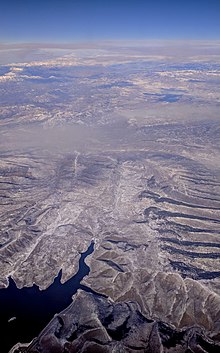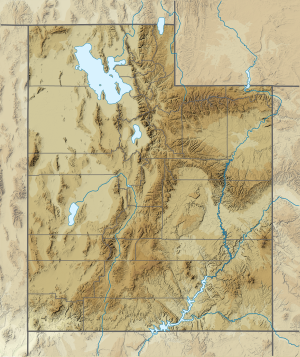Price River: Difference between revisions
more endangered fish and ref, moving river length to topical paragraph |
mNo edit summary |
||
| Line 64: | Line 64: | ||
==Watershed and Course== |
==Watershed and Course== |
||
[[File:Scofield Reservoir aerial.jpg|thumb|left|The [[Scofield Reservoir]] flows into the Price River (lower right).]] |
[[File:Scofield Reservoir aerial.jpg|thumb|left|The [[Scofield Reservoir]] flows into the Price River (lower right).]] |
||
The Price River watershed comprises {{convert|1900|sqmi|km2}}.<ref>{{cite report |title=Reconnaissance of Chemical Quality of Surface Water and Fluvial Sediment in the Price River Basin, Utah |author=J. C. Mundorff |publisher=United States Geological Survey |location=Salt Lake City, Utah |year=1972 |pages=55 }}</ref> The river originates at [[Scofield Reservoir]] in the [[Wasatch Plateau]] in [[Carbon County, Utah|Carbon County]] in central Utah. From the reservoir the river flows briefly eastward and northeastward into Utah County where it receives the flows of the [[White River (Price River tributary)|White River]] at [[Colton, Utah|Colton]]. The White River drains the [[Tavaputs Plateau]]. From there the Price River proceeds southeastward back into [[Carbon County, Utah|Carbon County]] and passes through Price Canyon, alongside [[U.S. Route 6]], to the cities of [[Helper, Utah|Helper]] and [[Price, Utah|Price]]. The canyon of the Price River is a [[physiographic]] break between the Wasatch Plateau and the [[Book Cliffs]].<ref name=Hydrology>{{cite report |title=Hydrology of the Price River Basin, Utah with emphasis on Selected Coal-Field Areas. U.S. Geological Survey Water-Supply Paper 2246 |authors=K. M. Waddell, J. E. Dodge, D. W. Darby, and S. M. Theobald |publisher=United States Government Printing Office |location=Washington, D.C. |year=1986 |pages=52 | url=https://pubs.usgs.gov/wsp/2246/report.pdf |accessdate=October 30, 2020}}</ref> Next, the Price River receives Willow Creek, the largest tributary in the Book Cliffs are with a watershed of {{convert|81|sqmi|km2}}.<ref name=Hydrology/> As it continues southeast, the river flows along the northeastern edge of the [[San Rafael Swell]] to the [[ghost town]] of [[Woodside, Utah|Woodside]], at which point it proceeds to the east, joining the [[Green River (Utah)|Green River]] in [[Gray Canyon]], about {{convert|20|mi|km |
The Price River watershed comprises {{convert|1900|sqmi|km2}}.<ref>{{cite report |title=Reconnaissance of Chemical Quality of Surface Water and Fluvial Sediment in the Price River Basin, Utah |author=J. C. Mundorff |publisher=United States Geological Survey |location=Salt Lake City, Utah |year=1972 |pages=55 }}</ref> The river originates at [[Scofield Reservoir]] in the [[Wasatch Plateau]] in [[Carbon County, Utah|Carbon County]] in central Utah. From the reservoir the river flows briefly eastward and northeastward into Utah County where it receives the flows of the [[White River (Price River tributary)|White River]] at [[Colton, Utah|Colton]]. The White River drains the [[Tavaputs Plateau]]. From there the Price River proceeds southeastward back into [[Carbon County, Utah|Carbon County]] and passes through Price Canyon, alongside [[U.S. Route 6]], to the cities of [[Helper, Utah|Helper]] and [[Price, Utah|Price]]. The canyon of the Price River is a [[physiographic]] break between the Wasatch Plateau and the [[Book Cliffs]].<ref name=Hydrology>{{cite report |title=Hydrology of the Price River Basin, Utah with emphasis on Selected Coal-Field Areas. U.S. Geological Survey Water-Supply Paper 2246 |authors=K. M. Waddell, J. E. Dodge, D. W. Darby, and S. M. Theobald |publisher=United States Government Printing Office |location=Washington, D.C. |year=1986 |pages=52 | url=https://pubs.usgs.gov/wsp/2246/report.pdf |accessdate=October 30, 2020}}</ref> Next, the Price River receives Willow Creek, the largest tributary in the Book Cliffs are with a watershed of {{convert|81|sqmi|km2}}.<ref name=Hydrology/> As it continues southeast, the river flows along the northeastern edge of the [[San Rafael Swell]] to the [[ghost town]] of [[Woodside, Utah|Woodside]], at which point it proceeds to the east, joining the [[Green River (Utah)|Green River]] in [[Gray Canyon]], about {{convert|20|mi|km}} of [[Green River, Utah]]. |
||
[[Range Creek]] is one of its tributaries. The average discharge is approximately 337 cfs. |
[[Range Creek]] is one of its tributaries. The average discharge is approximately 337 cfs. |
||
Revision as of 22:49, 2 November 2020
| Price River | |
|---|---|
 The Price River in Price Canyon, June 2010 | |
| Location | |
| Country | United States |
| State | Utah |
| Region | Carbon, Utah, and Emery Counties |
| Cities | Colton, Royal, Castle Gate, Helper, Spring Glen, Carbonville, Price, Wellington, Woodside |
| Physical characteristics | |
| Source | Scofield Reservoir |
| • location | Northern edge of the Manti–La Sal National Forest and Wasatch Plateau |
| • coordinates | 39°47′13″N 111°07′24″W / 39.78694°N 111.12333°W[1] |
| • elevation | 7,618 ft (2,322 m) |
| Mouth | Confluence with the Green River |
• location | 20 miles (32 km) north of Green River, Utah |
• coordinates | 39°10′46″N 110°06′23″W / 39.17944°N 110.10639°W[1] |
• elevation | 4,140 ft (1,260 m) |
| Basin size | 170 sq mi (440 km2) |
| Basin features | |
| Tributaries | |
| • left | White River, Willow Creek |
The Price River is a 137-mile-long (220 km)[2][3] southeastward flowing river in Carbon, Utah and Emery counties in eastern Utah. It is tributary to the Green River, itself a tributary to the Colorado River.
History
The river's early name was the White River, but it was changed in the summer of 1869 when LDS Bishop William Price of Goshen, Utah, explored the region and renamed it, making the White River above Colton into a tributary of the Price River.[4] The town of Price was later named after the river.[5]
Watershed and Course

The Price River watershed comprises 1,900 square miles (4,900 km2).[6] The river originates at Scofield Reservoir in the Wasatch Plateau in Carbon County in central Utah. From the reservoir the river flows briefly eastward and northeastward into Utah County where it receives the flows of the White River at Colton. The White River drains the Tavaputs Plateau. From there the Price River proceeds southeastward back into Carbon County and passes through Price Canyon, alongside U.S. Route 6, to the cities of Helper and Price. The canyon of the Price River is a physiographic break between the Wasatch Plateau and the Book Cliffs.[7] Next, the Price River receives Willow Creek, the largest tributary in the Book Cliffs are with a watershed of 81 square miles (210 km2).[7] As it continues southeast, the river flows along the northeastern edge of the San Rafael Swell to the ghost town of Woodside, at which point it proceeds to the east, joining the Green River in Gray Canyon, about 20 miles (32 km) of Green River, Utah.
Range Creek is one of its tributaries. The average discharge is approximately 337 cfs.
The Scofield Reservoir was formed by the construction of the Scofield Dam in 1946. Scofield Reservoir is fed by Pondtown Creek[8], Mud Creek[9], and Fish Creek[10], the primary tributary to the reservoir. There are plans to build a second dam on the river, upstream from the Scofield Reservoir, called the Gooseberry Narrows Dam near the confluence of Gooseberry Creek[11] with Fish Creek. The proposal has met with opposition out of concern for environmental impacts on trout fisheries in the Price River headwaters and the planned diversion of the water impounded by the dam out of the Colorado River basin to supplement the irrigation systems of the Sanpete Valley.[12] As a result of the planned dam the Price River was included on the American Rivers list of the top ten endangered rivers in the United States in 2005.[13]
Ecology
The headwaters of the Price River harbor Colorado River cutthroat trout ((Oncorhynchus clarki pleuriticus). Distribution and abundance of this cutthroat trout subspecies are now limited to small populations in less than 1% of its historic range in the upper tributaries of the Colorado River watershed. The chief vulnerability of Colorado River cutthroat trout is hybridization with non-native rainbow trout and competitive replacement by non-native brown trout (Salmo trutta) and brook trout (Salvelinus fontinalis).[14]
The federally endangered Colorado pikeminnow (Ptychocheilus lucius) is extant in the lower 143 kilometres (89 mi) of the Price River.[14] Three other imperiled fishes of the upper Colorado River basin, whose habitat is high desert streams, are the roundtail chub (Gila robusta), the flannelmouth sucker (Catostomus latipinnis), and the bluehead sucker (Catostomus discobolus). All three inhabitat or inhabited the lower Price River until the roundtail chub was likely extirpated from the Price River due to low flows in 1977 and 1993, a localized rotenone detoxification problem in 1977, and/or multiple other pollution-caused fish kills.[15]
Recreation
The Price is a small, shallow river and is normally unnavigable. However, during high springtime flows, the 23.5 miles (37.8 km) below the Scofield Dam to Castle Gate contain Class I to V whitewater.[16] The river has become increasingly popular with canoeists and kayakers.
See also
References
- ^ a b U.S. Geological Survey Geographic Names Information System: Price River
- ^ U.S. Geological Survey. National Hydrography Dataset high-resolution flowline data. The National Map, accessed October 30, 2020
- ^ "Salt Pickup by Overland Flow in the Price River Basin, Utah". Water Resources Bulletin. 14 (5): 1187–1200. 1978 =. Retrieved October 30, 2020.
{{cite journal}}: Check date values in:|year=(help); Cite uses deprecated parameter|authors=(help) - ^ John W. Van Cott (1990). Utah Place Names: A Comprehensive Guide to the Origins of Geographic Names: a Compilation. University of Utah Press. p. 303. ISBN 9780874803457.
- ^ "Utah History Encyclopedia: Price". University of Utah. Retrieved September 10, 2006.
- ^ J. C. Mundorff (1972). Reconnaissance of Chemical Quality of Surface Water and Fluvial Sediment in the Price River Basin, Utah (Report). Salt Lake City, Utah: United States Geological Survey. p. 55.
- ^ a b Hydrology of the Price River Basin, Utah with emphasis on Selected Coal-Field Areas. U.S. Geological Survey Water-Supply Paper 2246 (PDF) (Report). Washington, D.C.: United States Government Printing Office. 1986. p. 52. Retrieved October 30, 2020.
{{cite report}}: Cite uses deprecated parameter|authors=(help) - ^ U.S. Geological Survey Geographic Names Information System: Pondtown Creek
- ^ U.S. Geological Survey Geographic Names Information System: Mud Creek
- ^ U.S. Geological Survey Geographic Names Information System: Fish Creek
- ^ U.S. Geological Survey Geographic Names Information System: Gooseberry Creek
- ^ "Utah Rivers Council - Gooseberry Dam". Utah Rivers Council. Archived from the original on September 8, 2006. Retrieved September 10, 2006.
- ^ "Utah's Price River "Most Endangered"". KUTV.com. Archived from the original on September 26, 2007. Retrieved September 10, 2006.
- ^ a b "Ecology and Conservation of Native Fish in the Upper Colorado River Basin" (PDF). American Fisheries Society Symposium. 45: 157–204. 2005. Retrieved October 30, 2020.
{{cite journal}}: Cite uses deprecated parameter|authors=(help) - ^ "Conservation and Management Plan for Three Fish Species in Utah. Addressing needs for Roundtail Chub (Gila robusta), Bluehead Sucker (Catostomus discobolus),and Flannelmouth Sucker (Catostomus latipinnis). Publication Number 06-17" (PDF). Salt Lake City, Utah: Utah Department of Natural Resources Division of Wildlife Resources. September 1, 2006: 82. Retrieved October 30, 2020.
{{cite journal}}: Cite has empty unknown parameter:|authors=(help); Cite journal requires|journal=(help) - ^ "Price River, Utah". southwestpaddler.com. Retrieved September 10, 2006.

